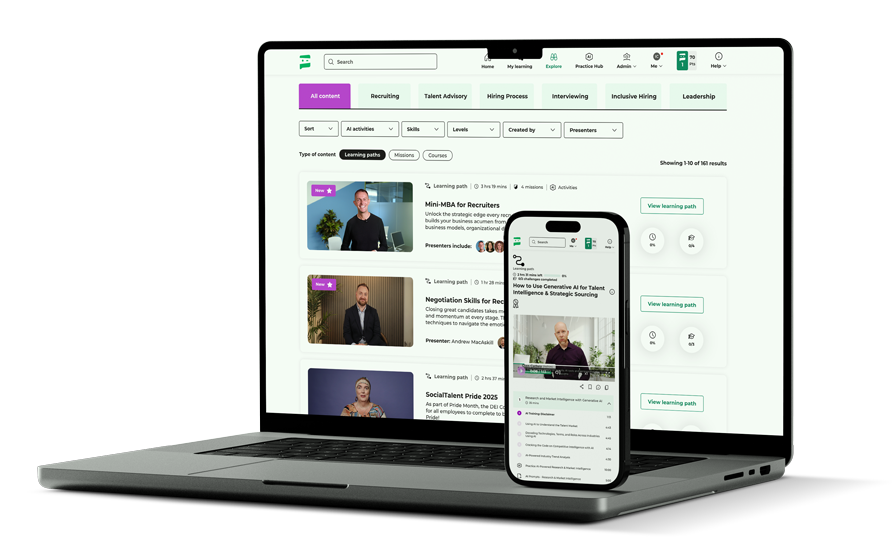Mind the Empathy Gap: Rebuilding Candidate Trust in the Age of AI
A friend of mine, Ryan Stene, recently posted on LinkedIn about his job search. Ryan’s a well-known TA leader – someone with a strong network, deep credibility, and a track record of results. But none of that protected him from a painful truth many candidates face: being ghosted. Not once, but repeatedly. He went through multiple interviews, had positive conversations, even moments of genuine excitement – and then… silence.
That post really stuck with me.
Because here’s someone who understands hiring better than most. Someone who knows what’s happening behind the curtain. Someone who can empathize with the recruiters on the other side. And still, the experience left him crushed.
So what chance does everyone else have?
The Empathy Gap Is Getting Worse in Candidate Experience
In 2025, applying for a job often feels like shouting into the void. Ryan described it as a 9-5 job in itself, which is no exaggeration. Most candidates spend hours personalizing their CVs, preparing for multiple rounds of interviews, and completing unpaid tasks or take-home projects – all with the hope of progressing to the next stage. And what do they get in return? A generic rejection email. If they get a response at all.
There’s a gap emerging – not just between candidates and companies, but between the effort people are investing in the hiring process, and the level of empathy they receive in return. Despite all our conversations about improving candidate experience, this gap isn’t narrowing. It’s widening.
Are We Solving the Wrong Hiring Problem?
It’s easy to point fingers, but recruiters aren’t the villains here. Most are dealing with overwhelming workloads, pressured to move fast, adopt new AI tools, and manage hundreds – sometimes thousands – of applicants at once. Technology solutions like HiringScore or Workday automations help manage this flood of applications more efficiently.
But we have to ask ourselves: who is this really helping?
Because even with better sorting tools, the end result for the candidate is often the same. They still feel unseen. They still feel disposable. And they often walk away with a worse opinion of your company than when they started.
As someone once said to me, “We’re not in the hiring business – we’re in the rejection business.” And when you’re rejecting 95–99% of applicants, how you handle rejection becomes just as important as how you handle hiring.
What If We Flipped the Funnel?
Now imagine a different kind of experience.
A candidate sees a job and uploads their CV. Before they even hit submit, an AI reviews their profile and responds with something like:
“We can see why this role caught your attention, but based on what we’re looking for, it might not be the best fit. Here’s why. And here are two other roles where people with your background have thrived.”
Instead of being rejected, they’re redirected – and respected.
This tiny shift reframes the role of AI in hiring. It becomes more than just a high-volume filter; it becomes a kind of digital career concierge. Candidates still have the choice to apply, but most will opt out of roles that don’t match if they have that insight early. That saves time on both sides. And more importantly, it preserves dignity.
This is the kind of AI-enabled empathy we should be investing in – using technology not just to optimize efficiency, but to deliver better, more human outcomes.
Ghosting Isn’t a Bandwidth Issue – It’s a Design Flaw
But the real pain point – the one Ryan and countless others talk about – doesn’t happen at the beginning. It happens later.
It’s when a candidate has already invested emotionally. They’ve shown up to interviews, built rapport, shared their stories and ambitions. And then… nothing. No closure. No next step. Just silence.
Let’s be clear. That’s not a bandwidth issue. That’s not an AI failure. That’s just a lack of care.
Some companies are trying to solve this. One employer I spoke to implemented a simple rule: reject candidates using the same medium you used to engage them. If you did a final interview over Zoom, have the decency to deliver the outcome over Zoom. If the communication was over email, at least make that email thoughtful and personal.
Others go one step further, offering rejected candidates the option to book a feedback call through a calendar link. Most don’t take them up on it. But the very act of offering that choice shifts the power dynamic. It shows that someone took their time seriously. That someone gave a damn.
One TA leader I know even closes interviews with real-time feedback. He’ll say, respectfully and clearly, what he was looking for, what he heard, and why the candidate won’t be moving forward. It’s honest. It’s human. And it respects the emotional weight of the process.
Learn more: Has Positive Candidate Experience Become the Exception Rather than the Rule?
Empathy Doesn’t Take Time. It Takes Intention
The most common pushback I hear is: “We’d love to do this better, but we just don’t have the time.”
And I get it. But the truth is, if your hiring process isn’t built to allow for empathy at scale, you’ll never find the time.
Empathy in recruitment isn’t about heroic one-off gestures. It’s about building systems and habits that show candidates they matter – even when the answer is no.
Start by rethinking the design of your hiring process:
- Smarter screening at the front to avoid mismatched applications.
- Transparent communication throughout each stage.
- Scalable feedback tools – like structured rejection templates or optional feedback calls – that make care repeatable.
It’s not about being perfect. It’s about showing you tried. Because candidates remember effort. They remember when a company made them feel like more than a number.
Bad Candidate Experience Leaves a Lasting Mark
One final reminder: the vast majority of people you reject today are also future customers, advocates – even future hires.
Especially in consumer-facing industries, poor candidate experience can do more than damage your employer brand. It can harm your business.
People don’t just get disillusioned with your hiring process. They associate that frustration with your company as a whole. They stop applying. They stop recommending. They stop buying.
Candidate experience isn’t just a recruitment problem – it’s a brand problem, a trust problem, and a long-term growth problem.
Rethinking Candidate Experience for the AI Era
So where do we go from here?
If candidate experience is getting worse, it’s not because we don’t care. It’s because we haven’t yet figured out how to scale care – how to bring empathy into high-volume, high-speed hiring environments.
AI can be part of the solution. But only if we use it to support better human experiences – not to replace them.
At the end of the day, every applicant is someone’s future colleague, customer, or competitor. And how we treat them matters.
As SocialTalent’s own candidate experience expert Andrew MacAskill puts it:
“Never forget what it feels like to be on the job market.”
Bring that empathy back into the process. Design for dignity. Because candidate experience isn’t just a nice-to-have anymore. It’s how your company will be remembered.
This article originally appeared in Johnny Campbell’s Talent Leadership Insights LinkedIn newsletter. Click here to subscribe!




